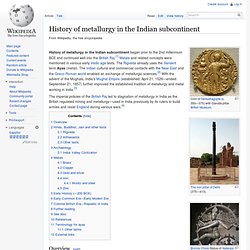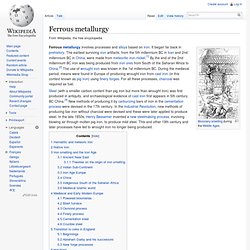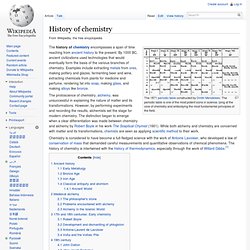

History of metallurgy in the Indian subcontinent. Dagger and its scabbard, India, 17th—18th century.

Blade: Damascus steel inlaid with gold; hilt: jade; scabbard: steel with engraved, chased and gilded decoration. Akbarnama—written in August 12, 1602—depicts the defeat of Baz Bahadur of Malwa by the Mughal troops in 1561. The Mughals extensively improved metal weapons and armor used by the armies of India. Hyder Ali (c. 1722-1782)—the ruler of the Kingdom of Mysore until 1782—developed military rockets using metal cylinders to contain the combustion powder.
History of metallurgy in the Indian subcontinent began prior to the 2nd millennium BCE and continued well into the British Raj.[1] Metals and related concepts were mentioned in various early Vedic age texts. The imperial policies of the British Raj led to stagnation of metallurgy in India as the British regulated mining and metallurgy—used in India previously by its rulers to build armies and resist England during various wars.[4] Overview[edit] Rigveda[edit] Arthasastra[edit] History of ferrous metallurgy. Ferrous metallurgy involves processes and alloys based on iron.

It began far back in prehistory. The earliest surviving iron artifacts, from the 5th millennium BC in Iran and 2nd millennium BC in China, were made from meteoritic iron-nickel.[1] By the end of the 2nd millennium BC iron was being produced from iron ores from South of the Saharan Africa to China.[2] The use of wrought iron was known in the 1st millennium BC. During the medieval period, means were found in Europe of producing wrought iron from cast iron (in this context known as pig iron) using finery forges. For all these processes, charcoal was required as fuel. Steel (with a smaller carbon content than pig iron but more than wrought iron) was first produced in antiquity, and archaeological evidence of cast iron first appears in 5th century BC China.[3] New methods of producing it by carburizing bars of iron in the cementation process were devised in the 17th century. Hematitic and meteoric iron[edit] Native iron[edit] Metallurgy. Georgius Agricola, author of De re metallica, an important early work on metal extraction Metallurgy is a domain of materials science and materials engineering that studies the physical and chemical behavior of metallic elements, their intermetallic compounds, and their mixtures, which are called alloys.

Metallurgy is also the technology of metals: the way in which science is applied to the production of metals, and the engineering of metal components for use in products for consumers and manufacturers. The production of metals involves the processing of ores to extract the metal they contain, and the mixture of metals, sometimes with other elements, to produce alloys. Metallurgy is distinguished from the craft of metalworking. Metallurgy is subdivided into ferrous metallurgy (sometimes also known as black metallurgy) and non-ferrous metallurgy or colored metallurgy. Etymology and pronunciation[edit] History[edit] Gold headband from Thebes 750–700 BC Extraction[edit] Alloys[edit]
History of chemistry. The 1871 periodic table constructed by Dmitri Mendeleev.

The periodic table is one of the most potent icons in science, lying at the core of chemistry and embodying the most fundamental principles of the field. The history of chemistry encompasses a span of time reaching from ancient history to the present. By 1000 BC, ancient civilizations used technologies that would eventually form the basis of the various branches of chemistry. Examples include extracting metals from ores, making pottery and glazes, fermenting beer and wine, extracting chemicals from plants for medicine and perfume, rendering fat into soap, making glass, and making alloys like bronze. The protoscience of chemistry, alchemy, was unsuccessful in explaining the nature of matter and its transformations.
Ancient history[edit] [edit] The earliest recorded metal employed by humans seems to be gold which can be found free or "native". Arguably the first chemical reaction used in a controlled manner was fire. Bronze Age[edit]